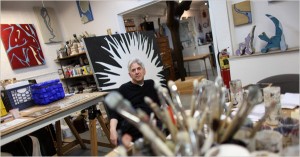
The artist in his studio.
Tobi Kahn, now 58, gave his mother a hand-made gift for her birthday every year throughout his life. They started as the sentimental hand-drawings of a child, but burgeoned into pieces worthy of the museum as he grew into a critically-acclaimed artist.
In early 2004, Kahn’s mother was diagnosed with pancreatic cancer, and lay dying in her hospital bed just a month later. Her son brought her bouquets of the flowers that she had always loved, but something in her treatment had made her sense of smell hyper-sensitive, and she could not stand the scent of the flowers in her room.
So, the artist turned to his paintings. He gathered a collection of his paintings of flowers and hung them around her hospital room, making what would become her deathbed a beautiful space for her other senses.
“We’re going from one place to another,” Kahn said, “and you should see beauty until the moment you leave.”
 Inspired by his mother’s experience, Kahn built a body of work whose purpose is to bring that beauty to the end of life. His collections have been displayed at the Guggenheim, the Museum of Biblical Art in New York, and the Museum of Contemporary Religious Art in St. Louis. He created various works for hospitals, hospices, and memorial chapels, ranging from single paintings to the design of an entire room for meditation.
Inspired by his mother’s experience, Kahn built a body of work whose purpose is to bring that beauty to the end of life. His collections have been displayed at the Guggenheim, the Museum of Biblical Art in New York, and the Museum of Contemporary Religious Art in St. Louis. He created various works for hospitals, hospices, and memorial chapels, ranging from single paintings to the design of an entire room for meditation.
After his mother’s death, Kahn began to ask clergymen and caretakers what kind of art people wanted to see at the end of life. He received recommendations and requests for details like soft, round edges, muted colors, low stimiuli, as well as broader, intangible ideas. He recalls specifically a request for art that imbued “a certain sense of dignity”.
 The work expresses not only the artist’s lifelong observance of Orthodox Judaism, but also his commitment to making connections across religious boundaries. His relationship to death has certainly been sorted throughout his life. His parents were survivors of the Holocaust, and he was named for an uncle who was killed by Nazis at the age of 23. He grew up in Washington Heights, New York City, among Jewish emigrants from Germany, so death and suffering were never a hidden subject to him.
The work expresses not only the artist’s lifelong observance of Orthodox Judaism, but also his commitment to making connections across religious boundaries. His relationship to death has certainly been sorted throughout his life. His parents were survivors of the Holocaust, and he was named for an uncle who was killed by Nazis at the age of 23. He grew up in Washington Heights, New York City, among Jewish emigrants from Germany, so death and suffering were never a hidden subject to him.
Yet, as a member of the Jewish priestly caste of Kohanim, Kahn is forbidden by religious law to attend a funeral of anyone but immediately family. This leaves him to express his grief through other outlets, which has probably had no small effect on his burgeoning creativitiy. When a girlfriend was stricken by cancer, the artist, in his mid-twenties, created a series of paintings that reflected her suffering during chemotherapry, as well as the anguish of Holocaust survivors.
 Through his personal grieving process, Kahn has dedicated eleven projects to his mother’s memory, all with themes that embody a certain reverance for nature, as well as the concept in Judaism of sanctifying something by making it beautiful.
Through his personal grieving process, Kahn has dedicated eleven projects to his mother’s memory, all with themes that embody a certain reverance for nature, as well as the concept in Judaism of sanctifying something by making it beautiful.
As the artist says, simply, Why shouldn’t the end of your life be beautiful?”
Sources:

 Tobi Kahn Creates Art to Make the End of Life Beautiful
Tobi Kahn Creates Art to Make the End of Life Beautiful


 First the Wealth Gap, Now the U.S. Has a Growing Health Gap
First the Wealth Gap, Now the U.S. Has a Growing Health Gap
 How to Comfort A Dying Loved One
How to Comfort A Dying Loved One
 Our Annual Seven Holiday Gifts for Someone Who Is Grieving, 2024 Edition
Our Annual Seven Holiday Gifts for Someone Who Is Grieving, 2024 Edition














